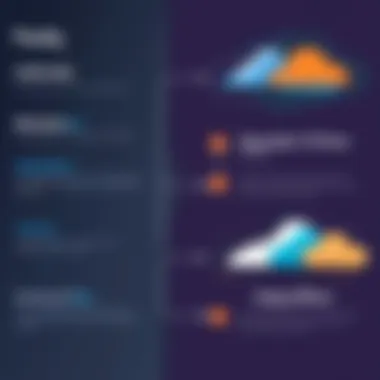Fastly vs Cloudflare: A Comprehensive Analysis


Intro
In the realm of digital content delivery, organizations face the task of aligning web performance and security with their specific needs. Two prominent players in this field are Fastly and Cloudflare. While both are content delivery networks (CDNs), they each offer unique functionalities and advantages tailored to various use cases. This analysis aims to provide a comprehensive overview of their features, pricing models, and which might be best suited for particular organizational strategies.
Software Overview
Purpose and Function of the Software
Fastly and Cloudflare exist to optimize the delivery of web content, ensuring faster loading times and enhanced security. Fastly primarily focuses on providing an edge cloud platform that enables developers to utilize real-time content management and instant purging capabilities. Cloudflare, on the other hand, is a full-service CDN that also integrates security features like DDoS protection and a web application firewall.
Key Features and Benefits
Fastly's architecture is built for speed and agility. It offers:
- Real-time caching: Content is delivered from the nearest location to the user, reducing latency.
- Instant purging: Changes are deployed almost instantly, allowing for seamless updates.
- Developer-focused: Extensive APIs are provided, enabling customization and integration.
Cloudflare boasts its own strong set of features:
- Robust security options: Such as DDoS protection and SSL/TLS encryption.
- Global reach: A wide network of data centers ensures high availability.
- User-friendly dashboard: Simplifies the management of settings and monitoring traffic.
Both Fastly and Cloudflare have their unique strengths, making them suitable for different organizational needs.
Installation and Setup
System Requirements
The setup for both Fastly and Cloudflare is relatively straightforward, but it is essential to ensure that your existing infrastructure can support their integration. Fastly works efficiently with modern development stacks and CDN-ready applications, while Cloudflare can integrate with virtually any site due to its comprehensive configuration options.
Installation Process
To use Fastly, follow these basic steps:
- Sign up for an account on the Fastly website.
- Configure your service: Input your domain details and set caching rules.
- Deploy your changes: Use the Fastly UI or API to activate your configurations.
For Cloudflare, the process is similar:
- Create an account on Cloudflare's website.
- Add your site to the dashboard and follow the instructions to change your DNS settings.
- Customize your security settings and performance options according to your needs.
Both platforms offer excellent documentation and support resources to assist users through their setup processes.
By examining the distinct functionalities and characteristics of Fastly and Cloudflare, users can better navigate their choices in CDN selection based on performance, security, and development needs.
Foreword to Content Delivery Networks
In the realm of digital communication, speed and reliability are paramount. Content Delivery Networks (CDNs) play a crucial role in ensuring that content reaches users efficiently, regardless of their geographical location. Understanding CDNs can help organizations optimize their web presence. They do this by caching content closer to end-users and distributing traffic across multiple servers.
Understanding the Role of CDNs
CDNs function as a distributed network of servers that deliver web content to users based on their geographical location. This technology works by storing cached versions of content in various locations, or nodes. When a user requests data, the CDN serves it from the nearest node rather than the origin server. This reduces latency and load times significantly.
The importance of CDNs extends beyond speed. They help in load balancing, which distributes traffic efficiently among multiple servers. This method enhances performance and prevents any one server from being overwhelmed by traffic. Furthermore, CDNs contribute positively to a website's security by absorbing large-scale attacks, such as DDoS attacks, where an influx of traffic could cripple a site.
Importance in Modern Web Infrastructure
In today's digital environment, where user expectations for speed and reliability are high, CDNs have become essential for maintaining web infrastructure. They not only facilitate faster load times but also enhance user experience through reduced buffering and smoother functionality. This is particularly critical for e-commerce platforms, media streaming services, and any site with dynamic content.
Moreover, the proliferation of mobile devices means that content is accessed from varied locations and networks. CDNs address these challenges by optimizing the delivery paths for mobile users. They simplify content distribution across different regions, ensuring that users have a consistent experience no matter where they are accessing the internet.
"Incorporating a CDN can result in vastly improved performance for organizations with global reach."


Another noteworthy aspect is the data redundancy that CDNs provide. By distributing content across multiple locations, users can still access data even if one server goes down. This redundancy is vital for maintaining uptime and reliability in a world where digital accessibility is crucial.
In summary, CDNs are integral to modern web infrastructure. They enhance performance, secure content delivery, and improve the overall user experience, making them indispensable for businesses aiming to thrive online.
Overview of Fastly
The exploration of Fastly's offerings provides a solid understanding of its potential in the CDN landscape. Fastly is recognized for its high performance and innovative features tailored for modern web applications. Engaging with its capabilities can help organizations optimize their digital strategies effectively.
Company Background
Fastly was founded in 2011. The company aims to provide a platform that accelerates and secures applications across the internet. With its headquarters in San Francisco, Fastly quickly gained traction due to its developer-centric approach, which places emphasis on real-time processing and flexibility. Understanding Fastly's origins is crucial for grasping how it developed the services that cater to a broad range of industrial needs.
Key Features of Fastly
Fastly differentiates itself through unique features that deliver exceptional results for its users. Below are some of the core functionalities that set Fastly apart:
Real-Time Logging and Analytics
Real-time logging is a standout feature for Fastly. This capability provides immediate insights into traffic patterns and performance issues. Users can analyze data without waiting for batch processes. This immediacy enables quick adjustments to optimize user experience. Being able to see logs as they happen allows for agile responses to incidents that may arise. However, extensive logging can incur additional costs, which is a factor some may consider.
Edge Cloud Platform
Fastly's Edge Cloud Platform facilitates the delivery of web content with lower latency. The architecture places services closer to users, which enhances performance metrics significantly. This arrangement allows for global reach with seamless experiences. Nevertheless, businesses must be aware of the potential complexities involved in deploying edge services. Understanding how to leverage this platform is key for maximizing benefits.
Instant Purge Capability
This feature is noteworthy because it allows users to delete outdated content instantly. Organizations frequently update their digital properties, so having the ability to purge cached files without delay is critical. Fastly's instant purge capability supports a dynamic web experience. One should consider that frequent purging could lead to performance fluctuations depending on traffic demands.
Custom Configuration
Custom Varnish Configuration Language (VCL) allows users to define custom caching rules. This flexibility is a significant advantage for developers looking to tailor content delivery to specific requirements. Fastly's approach to customizable configurations means enhanced performance for unique use cases. However, mastering VCL requires a level of expertise that some may find challenging initially.
Use Cases for Fastly
Utilizing Fastly can vary across different sectors. Here are a few prominent areas where Fastly excels:
E-commerce Websites
In the realm of e-commerce, Fastly ensures fast page loads and secure transactions. The CDN caters to high traffic during peak shopping periods, maintaining performance. This reliability fortifies customer trust. Fastly's features support the dynamic nature of e-commerce, which can significantly enhance user engagement and sales.
Media Streaming Services
For media services, Fastly offers quick content delivery, crucial for uninterrupted streaming experiences. By caching video and audio content at the edge, Fastly minimizes buffering. This reliability is essential for maintaining viewer satisfaction. The potential drawback may arise if the service encounters high spikes in traffic, necessitating efficient scaling strategies to avoid service degradation.
Dynamic Content Delivery
Fastly is adept at delivering dynamic content. Whether it’s user-generated content or frequent updates, Fastly supports responsive interactions effectively. The ability to refresh content in real time is invaluable in keeping users engaged. On the other hand, reliance on dynamic delivery can strain resources without proper management.
Overview of Cloudflare
In this section, we will delve into Cloudflare, a major player in the CDN space. Its significance lies in its ability to enhance speed, security, and performance for websites across various industries. Understanding its features and background is crucial for making comparisons with Fastly, another CDN provider. This exploration will help writers, developers, and IT professionals see which CDN best aligns with their specific needs.
Company Background
Cloudflare was established in 2009 and has quickly grown to become one of the leading content delivery networks worldwide. It aims to make the Internet secure, fast, and reliable. Cloudflare operates on a global network stretching across numerous data centers. This extensive network enables it to offer services such as CDN, web security, and performance optimization. The company has gained a reputation for its proactive approach to website security, and it handles a significant amount of Internet traffic daily.
Key Features of Cloudflare
Global Anycast Network


Cloudflare utilizes a global Anycast network, which allows users to connect to the nearest data center for faster response times. This characteristic makes it a preferred choice for organizations aiming for low latency. The unique feature of Anycast routing is that it can direct traffic based on geographic location. This capability effectively optimizes the user experience, especially for a global audience. Furthermore, this design can enhance redundancy and reliability. The benefits lead to better performance, but complexity in setup might arise for some users.
Web Application Firewall (WAF)
The Web Application Firewall provided by Cloudflare protects web applications from common threats and vulnerabilities. This key characteristic acts as a shield against attacks such as SQL injection and cross-site scripting (XSS). The WAF leverages machine learning to enhance its security protocols over time. Its unique feature is real-time threat intelligence, which updates automatically to stay ahead of new attack vectors. While it significantly boosts security, there can be a learning curve in customizing settings for specific needs.
DNS Management
Cloudflare offers advanced DNS management, which plays a vital role in ensuring rapid domain resolution. Its key characteristic is the speed and reliability it brings to DNS queries. Fast DNS resolution leads to a quicker loading time for websites, enhancing the overall user experience. One unique feature is CNAME flattening, allowing subdomains to bypass certain restrictions, contributing to streamlined management. However, transitioning DNS can be daunting for some users due to potential downtimes if not handled correctly.
Load Balancing
Load balancing by Cloudflare intelligently distributes incoming traffic across multiple servers. This feature is crucial for ensuring reliability and maintaining performance during traffic spikes. Its key characteristic includes geo-load balancing, which routes traffic based on user location, enhancing the site's resilience. This unique capability not only improves response times but also ensures availability. Despite these advantages, configuring load balancing may require a deeper understanding of server architecture for optimal results.
Use Cases for Cloudflare
Website Security and Protection
Website security is one of the primary use cases for Cloudflare. Its extensive security features make it a strong candidate for organizations that prioritize the safety of their online presence. The comprehensive protection offered ensures that websites remain safe from various threats.
Performance Optimization
Performance optimization is another important use case. Cloudflare provides tools that enhance website speed and reduce loading times. This optimization is invaluable for e-commerce platforms and content-rich sites.
Scalable Infrastructure
The scalable infrastructure of Cloudflare supports businesses of all sizes. As a company grows, its needs can evolve rapidly. Cloudflare’s framework efficiently supports such growth, making it a reliable option for future-proofing.
"Choosing the right CDN can significantly impact the performance and security of your website. Cloudflare's extensive features cater to diverse organizational needs, making it a suitable choice for many entrepreneurs and developers."
In summary, Cloudflare offers a robust array of services that focus on security, performance, and scalability.
Feature Comparison: Fastly vs Cloudflare
In the realm of web infrastructure, it is essential to understand how different content delivery networks stack up against each other. The feature comparison between Fastly and Cloudflare reveals essential insights into performance, security, and usability. By examining these features, technology enthusiasts and IT professionals can make informed choices tailored to their specific operational needs.
Performance Metrics
Latency Comparison
Latency represents the time taken for data to travel from a source to a destination. It's a critical aspect in determining how quickly content is delivered to end users. In this analysis, Fastly typically boasts lower latency due to its edge computing architecture, which places servers closer to users. This configuration is beneficial for dynamic content delivery, which is crucial for real-time applications such as gaming and financial services. However, while Fastly excels in scenarios requiring immediate data access, higher latency might be observed in regions where Fastly has less direct infrastructure.
Throughput Analysis
Throughput refers to the amount of data processed in a given time frame. It is another vital measure when evaluating content delivery networks. Both Fastly and Cloudflare offer impressive throughput capabilities, but they cater to different scenarios. Fastly's infrastructure is particularly adept at handling high demand during peak periods, which is vital for e-commerce and media services. Meanwhile, Cloudflare, with its expansive network, often excels in sustained throughput due to its ability to efficiently manage traffic spikes across its global network. However, the intricacies of throughput management can vary, and monitoring performance is wise for users with specific requirements.
Security Features
DDoS Protection
DDoS attacks are a growing threat in the digital landscape. Fastly and Cloudflare offer robust DDoS protection tailored to their infrastructures. Cloudflare is well-known for its integrated DDoS mitigation strategies, which protect against diverse attack vectors. Its extensive network ensures that malicious traffic is absorbed and filtered before it reaches the origin server. This characteristic makes Cloudflare a popular choice among users seeking comprehensive protection. Conversely, Fastly also provides DDoS protection but focuses more on routing traffic within its network, which might not be as aggressive as Cloudflare's approach. Users should consider their specific vulnerabilities when choosing between the two.
SSL Encryption
SSL encryption is crucial for ensuring secure connections between users and servers. Both Fastly and Cloudflare support SSL configurations, yet they have different strengths. Cloudflare automatically manages SSL certificates for users, simplifying deployment. This ease of use offers significant benefits for organizations that prefer a hands-off approach. Fastly, on the other hand, provides customizable SSL options, catering to users who require greater control over their security settings. However, the complexity introduced can require more technical knowledge, which might not be optimal for all scenarios.
Ease of Use
Management Interfaces


A seamless management interface can greatly enhance user experience when using a CDN. Fastly's interface provides an intuitive dashboard that allows users to easily access performance data and analytics. This design choice is essential for developers who require quick insights into their CDN usage. Cloudflare, while also user-friendly, presents an interface filled with numerous features that may overwhelm new users. Nevertheless, its diversity in functionalities caters well to seasoned professionals looking to optimize configurations.
Configurability
Configurability refers to how easily a CDN can be tailored to meet specific needs. Fastly excels in providing customizable options. Its users can configure settings precisely, which allows for a tailored user experience. This flexibility can be very appealing for organizations with unique requirements. On the other hand, Cloudflare's extensive feature set offers numerous built-in tools and applications, making it a more straightforward option for users who prioritize ease of deployment over fine-tuned customization. Those seeking deep configurability must weigh the benefits against the potential learning curve.
This detailed analysis of the features of Fastly and Cloudflare reveals that both have their strengths and weaknesses. Selecting the right one ultimately depends on the specific needs and context of the organization.
Pricing Models: Fastly vs Cloudflare
Understanding the pricing structures of Fastly and Cloudflare is crucial for organizations evaluating options for content delivery networks (CDNs). The cost implications can greatly influence decision-making, especially when scaling solutions for different business sizes and requirements. Thus, it is essential to analyze how pricing models are created by these two providers, considering their unique features, customer needs, and long-term benefits.
Fastly Pricing Structure
Fastly adopts a pay-as-you-go model, which aligns costs with actual usage. This flexibility appeals to businesses that experience varying traffic levels. Key components of Fastly's pricing structure include:
- Bandwidth Cost: Charged based on data transfer under different tiers. Businesses using large amounts can benefit from reduced rates as they scale.
- Requests Pricing: Additional fees apply per HTTP and HTTPS requests.
- Add-Ons: Fastly offers various add-ons, such as image optimization and real-time logging, which come with their own price tags. Users can select features based on specific project needs, allowing for customization.
One consideration is that this model might be more suitable for businesses expecting significant traffic fluctuations. However, estimating total costs can be challenging for users unfamiliar with their potential data transfers.
Cloudflare Pricing Structure
Cloudflare provides a tiered pricing model with several plans tailored to different types of users, ranging from individual developers to large enterprises. Its pricing includes:
- Free Plan: This plan offers basic CDN features and is particularly appealing for small websites or personal projects.
- Pro Plan: A monthly fee unlocks advanced features, including a Web Application Firewall. The Pro plan is suitable for growing businesses needing enhanced security.
- Business and Enterprise Plans: Monthly rates scale significantly and include more dedicated support, performance enhancements, and custom solutions.
Cloudflare's model is predictable, making budgeting easier for companies. The tiered structure allows businesses to choose a plan based on their requirements, but it may result in higher costs for companies that want to upgrade to advanced features.
Cost-Benefit Analysis
Evaluating the cost-effectiveness of Fastly and Cloudflare reveals trade-offs between flexibility and predictability. For potential users, key aspects to consider include:
- Traffic Patterns: Businesses with variable traffic might find Fastly’s pay-as-you-go model beneficial. In contrast, steady traffic may benefit from Cloudflare's set monthly fees.
- Feature Needs: If advanced security and performance optimization are priorities, the higher pricing plans of Cloudflare may justify those costs compared to Fastly’s add-ons.
- Scalability: Fastly’s pricing can become intricate without concrete traffic forecasts, while Cloudflare provides defined paths at clear cost increments.
In summary, businesses must align their current and projected usage with the respective pricing structures. Evaluating these pricing models is vital for making informed decisions in selecting a suitable CDN.
Customer Support and Resources
Understanding customer support and resources is critical in the decision-making process when choosing a CDN like Fastly or Cloudflare. These elements can significantly influence user experience and satisfaction. Efficient support can help resolve issues quickly, reducing downtime and improving the overall performance of web applications. Furthermore, robust documentation and resources empower users to troubleshoot minor problems independently. This aspect is especially vital for technology professionals and developers who may require immediate assistance when challenges arise.
Fastly Support Options
Fastly provides several support options to cater to various needs. They offer both standard and premium support plans. Regardless of the plan, users have access to email support, which allows for detailed issues to be addressed.
For users who require more immediate assistance, Fastly offers Live Chat support. This feature is quite beneficial for urgent issues, enabling users to communicate in real-time with technical support agents.
- Documentation and Resources: Fastly maintains comprehensive documentation, including installation guides, API references, and troubleshooting sections. These resources are vital for developers who want to exploit the full potential of the platform. The extensive knowledge base helps users find solutions to common issues independently.
- Community Support: In addition to formal support, Fastly fosters a community forum where users can ask questions, share knowledge, and interact with other users. This aspect encourages collaboration and learning within the Fastly ecosystem.
Cloudflare Support Options
Cloudflare offers a multi-tiered support structure that aligns well with different user needs. Their basic plan includes access to email support, but customers can upgrade to higher tiers for broader support features.
- Enterprise Support: For larger organizations, Cloudflare provides an Enterprise plan, which includes features like dedicated account managers and faster response times. This level of support ensures that businesses operating mission-critical applications receive the attention needed to maintain optimal performance.
- Extensive Documentation: Similar to Fastly, Cloudflare has an extensive library of documentation. This includes setup guides, API documentation, and detailed explanations of various features.
- Community and Forums: Cloudflare’s community support forum allows users to engage with other customers and Cloudflare experts. It's a platform for finding quick solutions and sharing best practices.
By analyzing the support options available from both Fastly and Cloudflare, users can better gauge which type of support aligns with their specific operational needs. Choosing the right CDN is not just about performance or features, but also about having a reliable support system in place that can assist during critical times.
Final Thoughts
The examination of content delivery networks is not merely an academic exercise but rather a critical consideration for organizations looking to maximize web performance and security. In today’s digital economy, choosing the right CDN can significantly impact user experience, site reliability, and security posture. As Fastly and Cloudflare each bring unique strengths to the table, making a well-informed decision is essential. This section captures key insights that underscore the decision-making criteria that should guide stakeholders in their pursuit of optimal CDN solutions.
When to Choose Fastly
Fastly is particularly favorable for enterprises dealing with dynamic content. Its emphasis on real-time logging and analytics serves developers who need immediate feedback on site performance. Users requiring granular control over how content is purged and configured will also find Fastly’s customizable VCL options advantageous. Additionally, websites that prioritize edge computing can leverage Fastly’s architecture for faster load times and reduced latency. Businesses in e-commerce, media streaming, or those relying on personalized content should prioritize Fastly due to its superior handling of complex, evolving web interactions.
When to Choose Cloudflare
Cloudflare presents a compelling choice for organizations focused on robust security features alongside performance. For those who seek an integrated approach to web protection—combining DDoS mitigation, a web application firewall, and enhanced SSL management—Cloudflare excels. Furthermore, companies that need a reliable DNS management solution and load balancing capabilities will find Cloudflare’s comprehensive toolkit beneficial. Consider Cloudflare when security is paramount, or if your company seeks effective growth with a scalable infrastructure that can adapt to increased traffic seamlessly.



